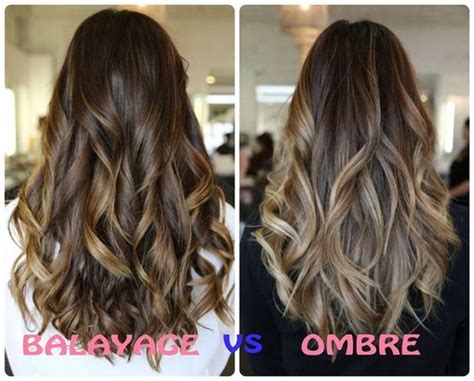Introduction
Hair coloring techniques have evolved over the years, and two of the most popular options are ombre and balayage. Both techniques offer a gradient effect, but they differ in their application methods and overall appearance. This comprehensive article explores the key differences between ombre and balayage, helping you make an informed decision about the best hair coloring technique for your desired look.

What is Ombre?
Ombre is a French word meaning “shadow.” In hair coloring, ombre refers to a technique where the hair is gradually lightened from the roots to the tips, creating a soft and subtle transition. The result is a natural-looking gradient, with the roots remaining darker and the ends becoming progressively lighter.
What is Balayage?
Balayage is a French technique that involves hand-painting hair color onto the surface of the hair. This method allows for a more customized and natural-looking gradient. The colorist uses a brush to apply the lightener to specific strands, creating soft, feathered highlights. Balayage typically results in a blended and sun-kissed look.
Ombre vs Balayage: Key Differences
| Feature | Ombre | Balayage |
|---|---|---|
| Application Method | Gradual lightening from roots to ends | Hand-painted highlighting |
| Result | Soft and subtle gradient | Blended and sun-kissed |
| Maintenance | Lower maintenance, less frequent touch-ups | Higher maintenance, requires more frequent touch-ups |
| Cost | Generally less expensive | Generally more expensive |
| Ideal Hair Types | All hair types | Fine to medium hair, as it can add volume |
Choosing Between Ombre and Balayage
The best hair coloring technique for you depends on your desired look and hair type. Ombre is ideal for those who want a natural-looking gradient with minimal maintenance. Balayage is a good choice for those who prefer a more customized and blended look, even with fine or medium hair.
Pros and Cons of Ombre
Pros:
- Soft and subtle gradient
- Low maintenance
- Suitable for all hair types
Cons:
- Can appear too harsh when done incorrectly
- Requires precise application to achieve a natural look
Pros and Cons of Balayage
Pros:
- Customized and natural-looking gradient
- Adds volume to fine or medium hair
- Can be used to create various effects
Cons:
- Higher maintenance, requires more frequent touch-ups
- More expensive than ombre
- Can be difficult to achieve a consistent look at home
Common Mistakes to Avoid
- Over-bleaching: Bleaching hair too much can damage it and create unwanted brassiness.
- Harsh transitions: Ombre and balayage techniques should create a smooth and blended gradient, avoiding abrupt transitions.
- Using the wrong products: Home hair coloring kits may not be suitable for ombre or balayage, leading to uneven results.
- Applying too much color: Over-coloring the hair can make it look unnatural and dull.
FAQs
1. How long do ombre and balayage last?
- Ombre typically lasts 6-8 weeks, while balayage can last up to 12 weeks.
2. Can I do ombre or balayage at home?
- Attempting ombre or balayage at home is not recommended without professional experience. These techniques require precision and skill to achieve a flawless look.
3. Which technique is better for covering gray hair?
- Both ombre and balayage can help camouflage gray hair, but balayage is generally more effective as it allows for more customized placement of highlights.
4. Can I combine ombre and balayage?
- Yes, it is possible to combine ombre and balayage to create a unique and personalized look.
5. What are the latest trends in ombre and balayage?
- Some popular trends include root smudging, shadow roots, and lived-in balayage, which create a more natural and effortless appearance.
6. How much do ombre and balayage cost?
- Ombre typically costs between $100-$200, while balayage can range from $150-$300, depending on the length and thickness of the hair.
7. How often should I touch up ombre and balayage?
- Ombre touch-ups are generally required every 6-8 weeks, while balayage touch-ups may be needed every 8-12 weeks.
Conclusion
Ombre and balayage are versatile hair coloring techniques that offer a range of options for creating flattering and stylish looks. By understanding the differences between these techniques and considering your desired result and hair type, you can choose the best option for you. With proper care and maintenance, you can enjoy a beautiful and long-lasting hair color.
